by Lucy Komisar
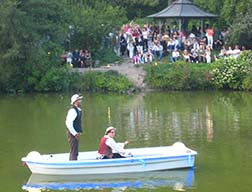
If you are in Berlin in mid-July, do not miss the city’s best party of the year!
A baritone in a straw hat sat in a rowboat in a pond surrounded by shrubs and trees. He sang opera and lieder to the delight of the dozens of people who stood at the water‘s edge. A piano in the bushes provided music through a speaker. The ducks seemed to enjoy it all.
When night fell, the baritone‘s boat was framed in a blue light, and globes along the shore provided illumination. Other people had taken the places of the earlier listeners. The singer was Lars Grünewoldt, and he was performing at a very special Berlin event that occurs only once a year.
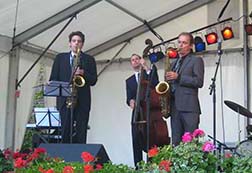
On a Saturday night in mid-July, Berlin‘s Botanical Gardens hosts the Botanische Nacht (Botanical Night), the city‘s best party of the year. It is the site of a combination open house and music festival, with performance venues set out over its 126 acres and booths of food and drink that patrons enjoy at café and picnic tables. The pi¨ce de résistance is fireworks to classical music.
At a large greenhouse courtyard often used for concerts, we heard The Toughest Tenors – horns, drums, base and keyboard — do swing numbers of big bands of the 50s and 60s. They were terrific.
There were about 12,000 people in the gardens, but the place is so large, you hardly notice. Walking down a path, we passed people dressed as garden gnomes and other fantastical characters.
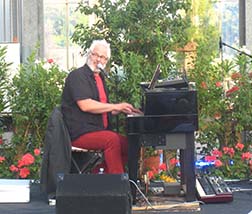
It was a change of pace to move a few minutes away to a hall inside a greenhouse to hear Thomas Putensen, a very popular German figure – composer, pianist, singer and film actor — whose repertoire moves between classical and jazz, including scat.
Think jazz plus “Eine kleine Nachtmusik.” When he sang the traditional songs, including old East German tunes, many in the audience joined in.
We stopped at a booth to buy succulent pork steak and wine.
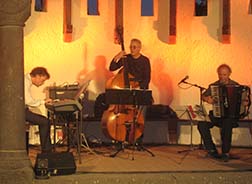
On a green swath of land, the Berolinas Linke Wade dance ensemble did Charleston and shimmy numbers from the 1970s to 1930s in original costumes. An accordionist played hokey music. Some people got up and danced.
At the stone Rosenpavilion, at a stage under stone arches, we heard the fine L‘Art de Passage band fill the air with jazz and tango.
When darkness fell, everybody stopped where they were, found a bench or a chair or just stood and looked over the green gardens at the pi¨ce de résistance, stunning fireworks.
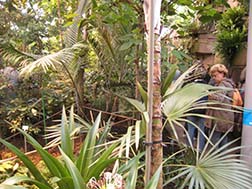
But Botanical Night is not only about music — and food and wine. People also wandered among plants and flowers in greenhouses and in the open air.
They could see some of the 22,000 species of plants and flowers set out among green lawns or in the tall glass greenhouses, including collections of cactus, orchids and even carnivorous plants.
Twelve rock gardens feature plants from different mountain regions, forests, swamps, heath, dunes and steppe vegetation. Some visited a Japanese garden and a Romanesque arbor of roses. One could see the plants associated with the tombs of the Egyptian Pharaohs.
The flares lit gardens that are more than 100 years old. They were established to conserve and display plants found in the German colonies. Now the Botanical Garden is part of the Free University and includes a museum and library.
The landscaped outdoors includes an Italian Garden, a carp pond, an arboretum and waterside plants. A garden with medicinal and poisonous plants is arranged in the shape of the human body, with about 230 medicinal plants set out in the part of the body design they might affect.

There‘s also a large garden with a focus on smelling and touching, designed especially for people who are visually impaired. The Berlin Botanical Garden is considered one of the three most important botanical gardens in the world and a World Heritage site.
The Great Pavilion, a gorgeous example of 19th-century glass and steel architecture, is the largest glass house in the world. It‘s famous for its giant bamboo. This tropical building is always heated at 86 degrees Fahrenheit! It‘s one of 15 greenhouses in the Garden. On Botanische Nacht, it looked almost magical.
Getting there
If you are traveling around Germany or Europe, you would do well to get a Eurailpass from RailEurope. It makes train travel within and between countries cheaper than single tickets. Passes are sold only to non-European residents. For information about the numerous passes that exist (ie. for 3 contiguous countries or for all of Europe) and to purchase passes, contact Rail Europe, or call 1-800-622-8600.
If you go
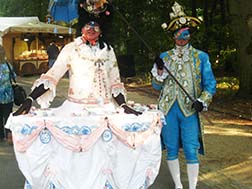
The Botanical Night began in 2009 at the Gardens, which are in Dahlem, the southwest part of the city, near the Free University. A map and timetable helps you navigate the performances, which are repeated as many as six times.
The next Botanical Night will be July 19, 2014, 5pm to 2am. For the price of a €38 ticket, one can come early and visit the gardens and greenhouses. To be sure of tickets, you can order them on line through Botanical Night and online ticket sellers Tixoo, Ticketonline and Eventim. Or by phone 49 (0)1805 / 44 70. The (0) is if you are calling from Germany.
Tickets at the box office in advance cost €35, on July 19 after 3pm they are €38 (now about $50). Tickets cost €32 plus booking fee from the private sellers, which makes the total come out to about the same. Children under 14 are free with proof of age.
Botanischer Garten Berlin-Dahlem
Königin-Luise-Platz
14195 Berlin
Tel 49 (0)30 8385 0100. Use the (0) only if calling from Germany.
Entrances at Königin-Luise-Platz (bus 101 or X83) or Unter den Eichen (bus M48). Get M48 at the Rathaus Stiglitz stop of the U-bahn.

